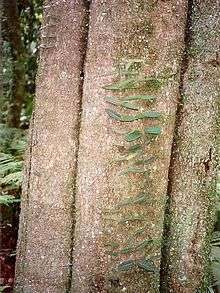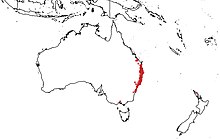Pouteria australis
Pouteria australis, also known by the synonym Planchonella australis, is a medium to tall rainforest tree of the family Sapotaceae native to Queensland and New South Wales, Australia. It is known by the common name black apple, wild plum, yellow buttonwood,[1] black plum and yellow bulletwood.[2]
| Black apple | |
|---|---|
 | |
| Fluted trunk of the black apple at Watagans National Park, Australia | |
| Scientific classification | |
| Kingdom: | Plantae |
| Clade: | Tracheophytes |
| Clade: | Angiosperms |
| Clade: | Eudicots |
| Clade: | Asterids |
| Order: | Ericales |
| Family: | Sapotaceae |
| Genus: | Pouteria |
| Species: | P. australis |
| Binomial name | |
| Pouteria australis (R.Br.) Baehni | |
 | |
| Occurrence data from AVH | |
| Synonyms | |
| |
Description
Pouteria australis grows as a tree reaching a maximum height of 30 metres (98 feet), with a fluted trunk up to 120 cm (47 in) diameter, with rough brown bark.[2] The leaves are simple, measuring 8–16 cm long and 2–5 cm wide, thick and leathery. The upper surface is shiny, lower surface paler green. They taper somewhat at the apex and base, rendering a somewhat diamond-shape. The flowers are generally axillary. Resembling plums in appearance, the edible fruit are 20–65 mm long, purplish or black, containing 2–5 brown and shiny seeds, 2 cm long. They ripen from September to November.[3] The plant bleeds a milky latex when cut or broken. Pouteria australis is protogynous; that is, the female parts of the tree mature before the male parts, to promote outcrossing.[4]
Distribution
The species ranges along the eastern coastline of Australia, from Bulburin in Queensland to the Illawarra region of New South Wales.[2] It grows in various types of rainforest, with specimens on the red basalt soil of the MacPherson Range attaining a large size.[2]
Taxonomy
The first European account of the tree is in Captain James Cook's logs of his 1770 exploration of the East coast of Australia. The tree was later described as Achras australis by Robert Brown in his 1810 work Prodromus Florae Novae Hollandiae,[5] before being moved to its current binomial name by Baehni in 1942.[6] The alternate name Planchonella australis was coined by Jean Baptiste Louis Pierre in 1890.[7] It belongs to the large genus Pouteria which occurs across the tropics from South America to Indonesia and into eastern Australia. A genetic analysis of Internal transcribed spacer RNA material found that Pouteria australis was most closely related a pair of species, Pouteria cotinifolia and Pouteria eerwah - the three forming a distinct group of Australian species within the genus.[8] An older analysis of DNA material placed it as sister taxon with Pouteria myrsinoides.[9]
Ecology
The green catbird eats the fruit,[2] and the seeds are eaten by rodents and insects.[10] Scientist Tim Flannery has proposed that the existence of rainforest trees with such large fruit indicates that a large fruit-eating bird (like a cassowary) once existed throughout its range as a propagator.[11]
Cultivation
Fast growing and easy to grow, Pouteria australis adapts readily to cultivation, preferring good drainage, as well as moisture, and extra fertilising. It is also tolerant of moderate frosts. It can be used in revegetation projects, and is propagated by seed or cuttings.[1]
Uses
The fruit of the black apple is edible out-of-hand. It has a sweet and fibrous flesh. However, it is also favoured by maggots, which are often found inside.[2] The taste has been reported as variable.[11] Indigenous Australians in the Gosford region are recorded as traditionally having eaten the seeds. The 1889 book 'The useful native plants of Australia' records "Black Apple" "Brush Apple" or Achras australis as being called "Jerra-wa-wah" in the Illawarra and Brisbane Waters areas of New South Wales.[12] The tree was originally harvested for its timber by colonialists. The attractively yellow-patterned wood is hard and suitable for making rulers.[2]
References
- Elliot, Rodger W.; Jones, David L.; Blake, Trevor (1997). Encyclopaedia of Australian Plants Suitable for Cultivation: Vol. 7. Port Melbourne: Lothian Press. p. 355. ISBN 0-85091-634-8.
- Floyd, Alexander G., Rainforest Trees of Mainland South-eastern Australia, Inkata Press 2008, ISBN 978-0-9589436-7-3 pp. 406-07.
- PlantNET, Planchonella australis plant profile
- Geoff Williams; Paul Adam (2010). The Flowering of Australia's Rainforests: A Plant and Pollination Miscellany. Collingwood, Victoria: CSIRO Publishing. p. 67. ISBN 978-0-643-09761-2. Retrieved 13 December 2010.
- "Achras australis R.Br". Australian Plant Name Index (APNI), IBIS database. Centre for Plant Biodiversity Research, Australian Government.
- "Pouteria australis (R.Br.) Baehni". Australian Plant Name Index (APNI), IBIS database. Centre for Plant Biodiversity Research, Australian Government.
- "Planchonella australis (R.Br.) Pierre". Australian Plant Name Index (APNI), IBIS database. Centre for Plant Biodiversity Research, Australian Government.
- Teguh Triono; Anthony H. D. Brown; Judy G. West; Michael D. Crisp (2007). "A phylogeny of Pouteria (Sapotaceae) from Malesia and Australasia". Australian Systematic Botany. 20 (2): 107–18. doi:10.1071/SB06011.
- Igor V. Bartish; Ulf Swenson; Jérôme Munzinger; Arne A. Anderberg (2005). "Phylogenetic relationships among New Caledonian Sapotaceae (Ericales): molecular evidence for generic polyphyly and repeated dispersal". American Journal of Botany. 92 (4): 667–73. doi:10.3732/ajb.92.4.667. PMID 21652444. Retrieved 13 December 2010.
- Rosemary H. Lott; Betsy R. Jackes (2001). "Isozyme Analysis of Rain Forest Plants Using Immature Seeds". Biotropica. 33 (1): 197–204. doi:10.1111/j.1744-7429.2001.tb00170.x.
- Fulton, Carl. "Facts Sheet No.4: A Local Rainforest Bushfood Garden" (PDF). Lake MacQuarie Landcare. Retrieved 12 December 2010.
- J. H. Maiden (1889). The useful native plants of Australia : Including Tasmania. Turner and Henderson, Sydney.